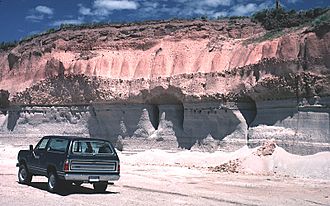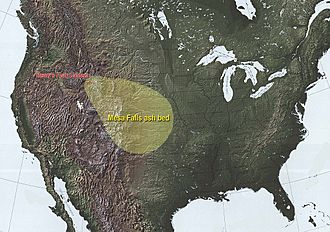Mesa Falls Tuff facts for kids
Quick facts for kids Mesa Falls eruption |
|
|---|---|

Mesa Falls Tuff exposed at southern rim of both the Island Park Caldera and the Henry's Fork Caldera near Ashton, Idaho.
|
|
| Volcano | Henry's Fork Caldera |
| Date | 1.3 million years ago |
| Type | Ultra-Plinian |
| Location | Idaho, United States 44°20′N 111°20′W / 44.33°N 111.33°W |
| VEI | 7 |

Extent of the Mesa Falls ash bed
|
|
The Mesa Falls Tuff is a special type of rock formed from volcanic ash and debris. It was created by a huge volcanic explosion called the Mesa Falls eruption. This eruption also formed a large bowl-shaped hollow in the ground known as the Henry's Fork Caldera. This caldera is located in Idaho, just west of Yellowstone National Park.
The Mesa Falls eruption happened about 1.3 million years ago. It was the second-largest caldera-forming eruption from the Yellowstone hotspot. This powerful event blasted out an incredible 280 cubic kilometers (about 67 cubic miles) of material! Before this eruption, the Huckleberry Ridge Tuff was formed by an even older Yellowstone hotspot eruption. After it, the Lava Creek Tuff was created by a more recent one.
Contents
What is Tuff?
Tuff is a type of rock made from volcanic ash and rock fragments. These materials are thrown into the air during a volcanic eruption. When they fall back to Earth, they settle and get compacted over time. This process creates a solid, light-colored rock.
Think of it like a natural concrete made from volcanic dust. The Mesa Falls Tuff is a famous example of this rock. It shows us how powerful ancient volcanoes were.
The Mesa Falls Eruption
The Mesa Falls eruption was an "Ultra-Plinian" type of eruption. This means it was extremely powerful and explosive. It sent a huge column of ash and gas high into the atmosphere. The eruption had a Volcanic Explosivity Index (VEI) of 7. A VEI 7 eruption is considered "super-colossal." It is one of the most powerful types of volcanic events.
When such a large amount of material is erupted quickly, the ground above the magma chamber can collapse. This collapse forms a large depression called a caldera. The Mesa Falls eruption created the Henry's Fork Caldera in this way.
The Henry's Fork Caldera
A caldera is a large, bowl-shaped hollow that forms after a major volcanic eruption. It is much larger than a typical volcano crater. The Henry's Fork Caldera is a great example of this. It was formed when the ground collapsed after the Mesa Falls eruption emptied the magma chamber below.
This caldera is now a scenic area. It is part of the larger Island Park Caldera complex. The caldera's shape helps geologists study the history of these massive eruptions.
The Yellowstone Hotspot
The Yellowstone hotspot is a place deep within the Earth where hot rock rises towards the surface. This creates a plume of magma that can melt the crust above it. This melted rock can then lead to volcanic eruptions.
The Yellowstone hotspot has been active for millions of years. It has caused many huge eruptions as the North American plate moves over it. The Mesa Falls eruption is one of the most significant events linked to this hotspot. It shows the long and powerful history of volcanism in the Yellowstone area.
See also
 In Spanish: Toba de Mesa Falls para niños
In Spanish: Toba de Mesa Falls para niños

